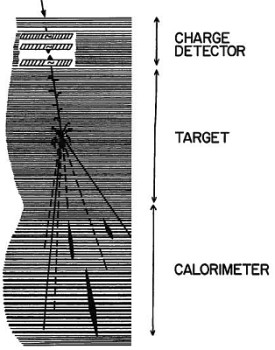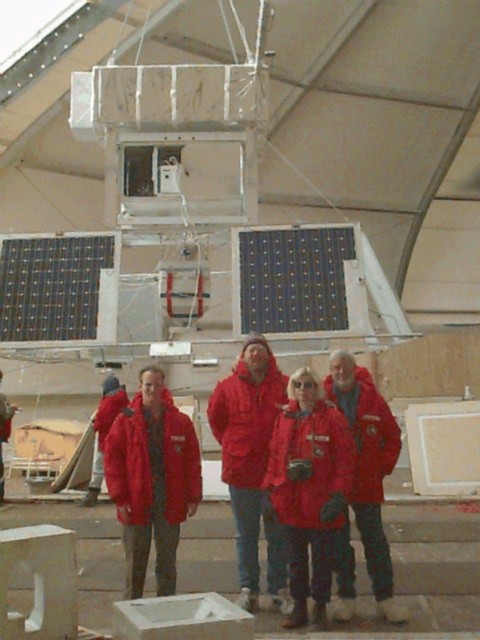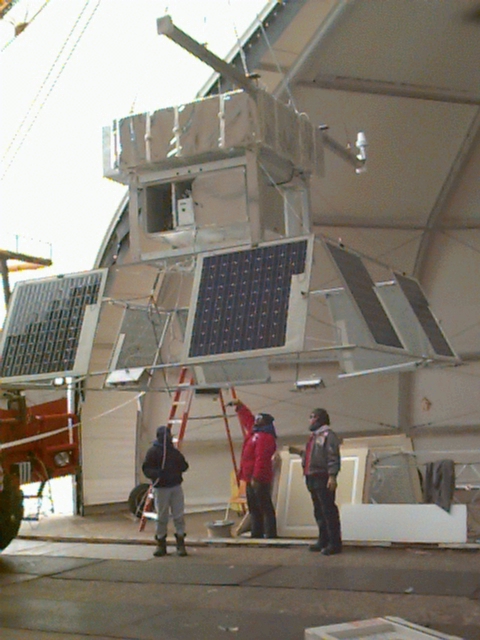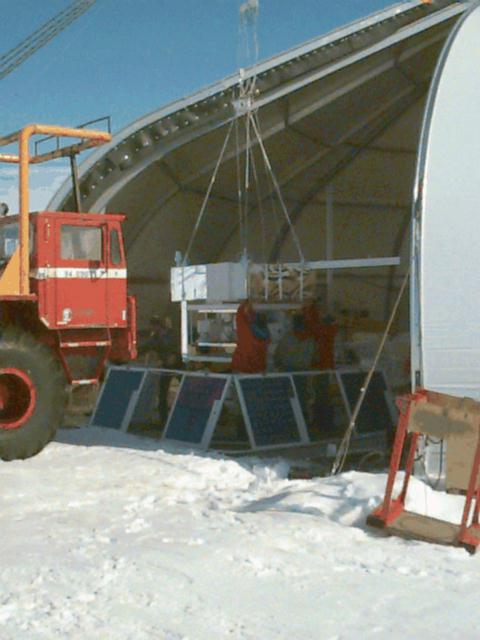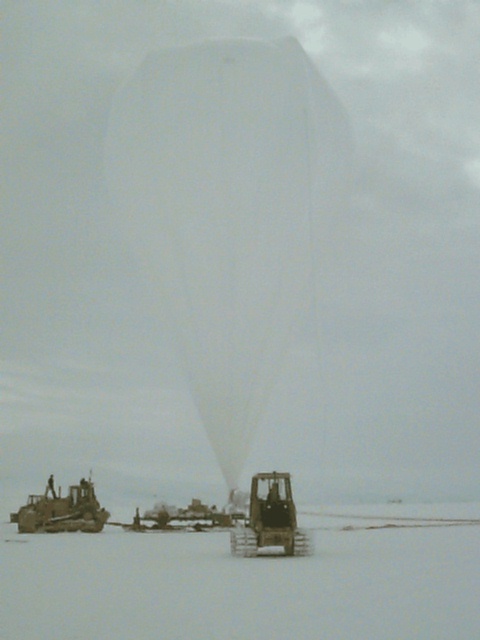Purpose of the flight and payload description
The Japanese American Collaborative Emulsion Experiment (JACEE) was a scientific effort carried out to measure the composition and spectra of primary cosmic rays at the top of the atmosphere, using emulsion chambers transported by stratospheric balloons. JACEE's first flight was conducted in 1979, and flights continued through 1996, totaling 14 flights and 13 successful missions. The collaboration leveraged Japanese expertise in photographic materials and microscopy, American expertise in ballooning and data analysis, and Polish resources in scanning and measurement of emulsions.
Each payload could contain one, three, or four chambers, each chamber with an area about 2000 cm2, 12~25 cm thick, and weighing ~120 kg. Figure at left shows a schematic diagram of the vertical configuration of one chamber. It was comprised of four sections, identifiable according to their function in the experiment. These are, from the top, the charge detector, the target, the spacer, and the calorimeter. All sections were multilayered stacks of track-sensitive materials (emulsions, x-ray films, CR-39, Lexan) alternated with absorbers (acrylic, lead). There were approximately 300 layers of emulsion in the chamber. This configuration was more or less the same for all the flights. However, many flights not included the spacer section, and in some cases were added other elements like Cerenkov detectors or plastic scintillators.
The charge detector employed thick (200 - 400 micron) emulsions, which permited accurate determination of the charge of each primary particle via measurements of the grain density, gap distribution, and/or delta ray distribution. The target section was comprised basically of thin (50 ~ 75 micron) emulsion plates alternated with acrylic sheets. The substantial mass of low-Z material maximized the interaction probability, while the emulsion optimized the observation of charged tracks from an interaction vertex. In order to identify nuclear fragments, charge identification layers composed of thick emulsions and etchable plastics were inserted at regular intervals throughout the target.
The spacer section consisted of honeycomb paper with a few thin emulsions positioned at regular intervals that facilitated the tracing of tracks through it. Finally, the calorimeter was the energy measuring portion of the apparatus. It consisted of 1.0 and 2.5 mm thick lead sheets alternating with thin emulsion plates and x-ray films. Gamma rays emanating from a vertex in the target initiated electro-magnetic cascades in the calorimeter. The cascades produced dark spots in the x-ray films, the observation of which provided the trigger for an event. The events were traced back from the calorimeter, through the spacer, to the vertex in the target by observing associated tracks in the emulsions.
All flights made in Antarctica for JACEE after 1992 used the same gondola design: a simple, lightweight and very rugged framework that provided protection for the emulsion chamber modules in case of an awkward landing or parachute drag, wich also was easy to dissasemble on the landing spot or to be replaced in short notice at a low cost. The payload included an onboard data logging computer which was an adaptation of electronics originally designed for other project to record pressure altitude and module temperatures, as well as to control a shifter mechanism which moved upper emulsion layers out of registration when the gondola altitude was below 6 mbar. The JACEE data logger was interfaced to the NSBF SIP (Support Instrument Package) allowing status monitoring and data downloading during flight.
Details of the balloon flight
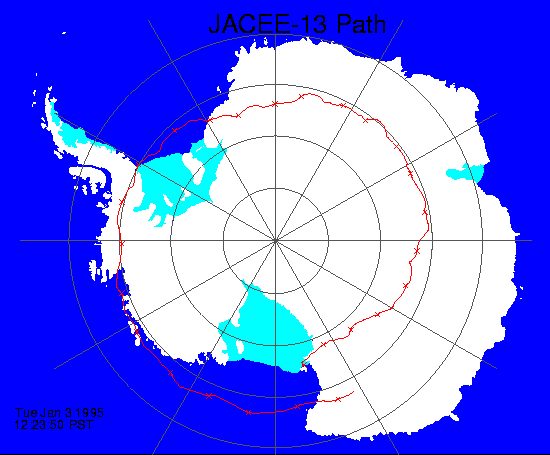
Balloon launched on: 12/21/1994 at 23:12 utc
Launch site: Williams Field, McMurdo Station, Antarctica
Balloon launched by: National Scientific Balloon Facility (NSBF)
Balloon manufacturer/size/composition: Zero Pressure Balloon Winzen 29.470.000 cuft - SF3-424.37-080-NSC-X-ST
Balloon serial number: W29.47-2X-09
Flight identification number: 391NT
End of flight (L for landing time, W for last contact, otherwise termination time): 1/3/1995 at 15:27 utc
Balloon flight duration (F: time at float only, otherwise total flight time in d:days / h:hours or m:minutes - ): ~ 13 d
Landing site: Victoria Land at 73 45' S, 152 22' E in Antarctica
Payload weight: 2940 lbs
Overall weight: 4576 lbs
The balloon, was launched by dynamic method on December 22, 1994 from McMurdo Station, and after a nominal ascent to float altitude it started a counter clockwise turn around the south pole. The balloon made one full revolution of Antarctica at an altitude of 131,000 feet. The balloon and payload were brought down by radio control from an ski-equipped Hercules LC-130 plane, on January 3 1995. At that time the LC-130 was unable to land and recover the payload due to ground fog in the landing area. On January 8 weather had improved and a second LC-130 was sent into the area but when they attempted to land they found the hard snow surface unsafe due to high, hard mounds of snow called sasturgi. Two days later a Twin Otter plane attempted to land in the same area with the same results.
The next try was made by helicopters from the U.S. Navy's Antarctic Development Squadron (VXE) 6 which traveled twice the normal range to perform the recovery. Working in close coordination with the Italian Antarctic Program they were able to use fuel that was already in place on the Antarctic Plateau for refueling. After almost four hours of flying across the near featureless terrain of the Polar Plateau, the crews arrived at the site around noon. The site was at a pressure altitude of 8,800 feet which made more difficult the task.
The payload, weighing almost 3 tons, had to be disassembled before being transported back to McMurdo. The helicopters' crews, along with Steven Peterzen, from NSBF where in charge of the task. Woking in harsh environment conditions and suffering symptoms of "altitude sickness" in four hours they had broken everything down and wrestled with the 600-pound parachute that had been filled by driven snow and was pulling them around in the 25 mile per hour winds. After that the two helicopters took two loads each down to a lower altitude place suitable for the landing of the Twin Otter plane. Finally the disassembled payload and parachute were back to McMurdo Station. After pumping fuel again for the return trip the helicopters returned to McMurdo with the rest of the scientific equipment 15 hours later.
JACEE-13 was one of the most succesful missions of the program logging 304 hours at float altitude.
External references
- JACEE experiment website Institute of Nuclear Physics PAN, Poland
- JACEE experiment website University of Washington Particle Astrophysics Group
- Antarctic Balloon Flights for JACEE 24th International Cosmic Ray Conference, Vol. 3, Pag. 615
- Cosmic Ray Astrophysics from Balloons in Antarctica Astrophysics From Antarctica; ASP Conference Series; Vol. 141; 1998, p.26
- Cosmic-Ray Proton and Helium Spectra: Results from the JACEE Experiment Astrophysical Journal Vol. 502 Pag 278, 1998
- Elemental abundance of high energy cosmic rays Nuclear Physics B - Proceedings Supplements - Vol. 60, Issue 3, p. 83
- Energy spectra and elemental composition of nuclei above 100-TeV from a series of JACEE balloon flights UWSEA PUB 94-07, Proc. 24th ICRC 2:707
- NASA Balloon Flights (1989-1998) in NASA Historical Data Book, Vol. VII: NASA Launch Systems, Space Transportation, Human Spaceflight, and Space Science, 1989-1998
2576If you consider this website interesting or useful, you can help me to keep it up and running with a small donation to cover the operational costs. Just the equivalent of the price of a cup of coffee helps a lot.

